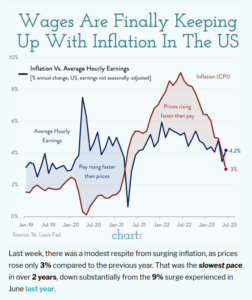If the data suggest price increases are driving inflation, the inflation “debate” ought to center on… prices not wages. Especially if the data also suggest wages are not driving inflation (very much). The one thing we should NOT do? Pretend the world is behaving in line with our pre-baked mental models when the data suggest otherwise…
On that note, lets have a look at wage and price growth over the last few years.
Very tidy chart. Where is the “wage price spiral” in the above? Definitely-not-left-wing economists Ben Bernanke and Olivier Blanchard, also don’t see wages as a driver of the recent inflation. Even though the business press writes as if wages are enemy #1…
While the initial worry was that the main channel would be through tensions in the labor market and resulting wage pressure, most of the movements in headline inflation have come from the goods markets, from price shocks, i.e. large increases in some prices given wages.
Yet we are still served up commentary like this in John Auther’s (Bloomberg) latest piece
The question, she poses, is whether the economy can break inflation in wages — or even the dreaded wage-price spiral — without a incurring a significant increase in job losses? How would that impact consumer confidence? “Yes, job losses have ticked up a little bit, but once people lose their jobs, they can find another job quite quickly,” she said. “And wage gains, though they’ve slowed, have not gotten negative.”
If anything, the chart might argue for a price-wage spiral? Price growth had been… (ahem)… robust. For example, Pepsi said they had raised prices 15% YoY per their last earnings call.
But a price-wage spiral looks pretty iffy too. Strip out the big YoY dip in 2021 (echo of the 2020 spike) and wage growth looks pretty flat at 4%.
Admittedly, Blanchard did nod in the direction of a possible future wage-price spiral, writing in May ’23. But this had a pro forma feel even 2 months ago. It also hasn’t aged well.
Yet Authers and a recent Economist Opinion piece keep looking for that wage-price spiral. The Economist ridicules the (admittedly unfortunate) term “greedflation” because, you see, price increases most certainly have NOTHING to do with companies pushing their price envelope under the cover of a crisis. The Economist, however, gets oddly vague about how else to describe the price data above. “The first rule of Fight Club is… never talk about Fight Club.”
Another hint at what might have driven recent inflation in this Fed chart:
NB: The big 2020 spike (and the 2021 echo dip) in earnings “growth” in the wage/price chart above is COVID. So many low wage workers were laid off that average hourly earnings went way up – only high earners were left in the “average earnings” calculation. That mostly tells you that ALL the data of the last few years is non-trending and suspect.


